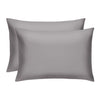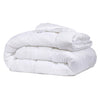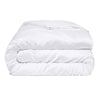The Daily Miracle
The Ultimate Guide to Pillow Cases: Everything from Buying to Cleaning
Published
January 19, 2021
Author
Nicholas Crusie

Pillow Talk. Not the intimate conversation you have with the partner holding you close at night, but a serious conversation about the pillow you hold close at night. Pillow cases are too often overlooked, with more thought going into the pillow itself - whether it’s too soft, too firm, or just right. But pillow cases are an essential part of your sleep, and their power is not to be underestimated.
Choosing your Pillow Case
Pillow cases are made of all different types of fabrics, both natural and synthetic. When beginning your search for that “just right” pillow case, start by picking the fabric first. For superior sleep and softness that lasts, go for a high-quality, all-natural fabric.
Silk and Satin
Silk is derived from fibers that develop from proteins secreted by silkworms, known for its softness and opulent look. Satin is a weave woven from silk threads at times, but more often woven from synthetic fibers like polyester or nylon. Silk is stronger with a more shimmery appearance while satin has a glossy surface with a dull reverse side.
Silk and satin pillow cases are all the rave right now - with claims to be good for the skin and hair. Sleeping on a natural silk pillow case reduces the friction between your skin and hair against the pillow, potentially resulting in less skin irritation and hair breakage.
Many silk pillow cases on the market claim that the silky slip also limits skin from creasing, tugging and pulling therefore keeping wrinkles at bay. Yet there is no hard evidence of this, and many experts say it is your sleep pattern that most affects your skin. For example, sleeping nightly on your left side will result in more wrinkles on the left side of your face. The best solution to minimizing the appearance of wrinkles is to sleep on your back.
Silk pillow cases do seem quite promising. The thing is, satin is one of the most costly fabrics in the world. Meaning you’d have to be willing to drop a hefty bag making it quite the investment. Often, real silk pillow cases are out of range for people and they tend to opt for the most affordable alternative: synthetic polyester that looks and feels like satin. Although the initial softness of satin and other polyesters used in place of satin can be tempting at first, that silky quality is actually less breathable, prone to wear, pilling, and is overall difficult to maintain.
Silk pillow cases must be hand-washed and hang dried, making it quite a chore once you find out below how often you should be washing your pillow cases *spoiler alert* every two to three days!
Cotton
There are three main varieties of cotton. American Upland, Pima, and Egyptian. American Upland can be short to long-staple, which refers to the length of the individual fibers. The longer the cotton staple, the softer the cotton fabric. Pima is a fine, long-staple cotton that yields a very soft weave. You will often see Pima Cotton labeled “Supima,” since it is trademarked. Egyptian cotton is of the finest, longest-staple of all. Grown in the Nile River Valley, Egyptian cotton produces a very soft, supple weave, and has the price tag to prove it.
Since cotton is so versatile, there are all different types of cotton weaves, which is the way the fibers are woven together to create the fabric. From the smooth, silky feel of sateen cotton to the crisp hotel-like percale weave, you have a range of cotton options that will provide whichever benefits you are searching for to perfectly suit your personal sleep style.
Sateen
Sateen is the closest to satin, without the high cost and fragile nature of that expensive fabric. It has a silky feel and sheen that is naturally wrinkle-resistant and tightly woven, making it ideal for year-round comfort.
Percale has a cool and crisp matte finish, and typically softens with each wash. It is durable, lightweight, and breathable, making it ideal for warm sleepers.
By selecting a high-quality cotton pillow case, you’re choosing a breathable, luxurious material that’s easy to maintain while staying soft for years.
Synthetic Fabrics
Synthetic fabrics such as Microfiber, or cotton mixed with polyester are soft, easy to clean, wrinkle-resistant, and affordable, but they can possibly be harmful to your health. Synthetic fibers are made with chemicals that have shown to have toxic effects. Microfiber consists entirely of polyester, polyamides, or in some cases, wood pulp. Polyester tends to be fairly thin, flammable, and contains electrons that attract hair and dust.
Polyester fiber doesn’t pair well with heat and sweat, making it responsible for some skin rashes, redness, and itching. If used over a long period of time, it can cause short or long-term respiratory infections.
These synthetic fabrics also have a much lower water absorption than natural fabrics, meaning they wick moisture, oftentimes overwicking, lead to dry hair and skin. This moisture includes the natural oils in your hair and skin, as well as your nightly moisturizer and deep conditioning hair treatment - getting sucked right up into your pillow.
The Truth about Pillow Cases
An overnight solution to problems like acne and allergies seems like a dream. But what if I told you the way you care for your pillow case directly affects your health? Because it does.
Your Skin
No matter what material you choose as your pillow case, if it’s not cared for properly, it becomes home to grime, dirt, and sweat whether it is cotton, silk, or satin.
Everything that can be found on your face can also be found on your pillow case. This means that the bacteria rubbing off your skin rubs onto your pillow, where it gets reintroduced to your skin nightly, irritating it over and over. It doesn’t matter how diligently you scrub your face at night, once your head hits the pillow, you’re facing a losing battle.
Your hair holds more dirt than anywhere else on your body, and whether you wash your face before bed or not, every night you mop your pillow with your hair and that bacteria spreads to your skin and neck.
You do have the option of sleeping on your back, but for those who move around in their sleep, this likely won’t be a successful resolution.
Your Health
A person sheds an average of 1.5 grams of skin each day. That amount of dead skin is enough to feed one million dust mites that live, reproduce, and spread their feces, which many people are allergic to.
Studies show that 99.9 percent of people have allergens in their bedroom, such as dust mites. Your pillow case may also be contaminated with pollen that has clung to your hair, meaning you’ll be breathing in allergens for about eight hours straight, making allergy symptoms worse.
Germs collecting on your pillow case actually weaken your immune system. Bacterial infections put you at a greater risk for bronchitis and other health conditions. To combat this, you can opt for anti-microbial fabrics, such as silk, that bacteria cannot grow on, keeping acne and other illnesses at bay.
New technology has introduced antibacterial silver-infused bedding, where the silver is woven into the cotton. Silver naturally has a positive charge while many bacteria have a negative charge. They are attracted to each other and the silver binds to the surface of the bacteria causing damage so it can not function properly and slowly dies off, unable to reproduce.
Cleaning your Pillow Case
The truth is, bed sheets should be washed at least once a week, but pillow cases should really be washed every two to three days. You likely spend anywhere from 49 to 63 hours on your pillow case a week, leaving plenty of time for sweat, oil, dirt, and maybe even makeup to build up, leading to skin issues like breakouts, allergies, and even fungal infections.
Wash day Routine
Since it is recommended to wash your pillow cases multiple times a week, consider having multiple pillow cases in your linen closet. Treat your pillowcases like your underwear and change them quite often. Toss them in the hamper and deal with them when you do the rest of your week’s laundry.
Pillow cases should always be washed in warm water to effectively kill germs. Colored clothing should be washed in cold water to retain their pigment, so be wary when washing pillow cases with the rest of your laundry. Pillow cases need plenty of room to get a thorough clean so try not to jam too many items together.
If this seems like too much work, perhaps you’d be better matched with an anti-microbial fabric such as silk or a silver-infused antibacterial cotton, where you can wash three times less.
Detergents and Stains
Chemicals can be damaging to the fibers of your pillow case, and fragrances in scented detergents and pillow sprays can irritate the skin. Always look for products that have all natural ingredients. A good rule of thumb is the less ingredients, the better. Be on the lookout for “gentle” detergents that are water-based, consist of baking soda, and (if your pillow case must smell like a Tahiti Escape) use essential oils for fragrance.
If you notice makeup or bodily fluids on your pillow case, simply work a tiny dab of detergent on the area with your fingertips. Let the detergent sit on the area for at least 15 minutes prior to adding to the wash. This gives it time to break apart the stain molecules before washing as usual.
Using fabric softener and dryer sheets can reduce the absorbency of the fabric’s natural fibers make sheets uncomfortable. Opt for naturally softening remedies, like one-half cup of distilled white vinegar to the fabric softener dispenser. This helps remove any soapy residue and keeps them from feeling stiff. This is especially recommended for silk sheets.
Caring for Silk
As we talked about before, silk is pretty high maintenance. To help it last longer, stay away from hot water as it destroys the natural silk fibers. Avoid bleach and stain removers as they too are damaging.
The best way to dry your silk pillow case is on a drying rack away from direct heat and any sources of direct sunlight. If you are in a hurry, tumble dry on the lowest heat setting and remove the pillow case while it is still slightly damp.
To store, make sure the pillow case is completely dry to prevent mildew from forming, and create a soft roll or fold before placing it on the shelf where it won’t be crushed.
Picking your Perfect Pillow
- If You’re a Back Sleeper: You will likely benefit from a thin pillow, so your neck is not pushed too far forward. Memory foam is a good option because it molds to the shape of your head and neck. You could also try sleeping with another pillow under your knees to alleviate pressure on your lower back.
- If You’re a Stomach Sleeper: Try to find the thinnest type of pillow - or no pillow at all. Sleeping on your stomach puts lots of stress on your lower back. You could try sleeping on your side instead and hugging a body pillow if you prefer something pressing on your stomach.
- If You’re a Side Sleeper: Go for an extra-wide firm pillow, this will help bridge the distance between your ear and shoulder. Also try sleeping with a pillow between your knees to better align your spine.
Summary
In conclusion, choosing the right pillow case and committing to cleaning it regularly can solve a whole lot of problems you probably didn’t even know you could solve. Reducing allergies, clearing up acne, and maintaining an overall improved health are some changes you may experience from paying a bit more attention to the fabric encasing your favorite pillow.
Did you know?
Your hair holds more dirt than anywhere else on your body.
Sources:
- https://austinpublishinggroup.com/textile-engineering/fulltext/arte-v2-id1012.php
- https://www.cnet.com/how-to/do-you-wash-your-sheets-enough-probably-not
- https://www.sleep.org/often-really-need-wash-bedding
- https://www.huffpost.com/entry/pillowcase-acne-beauty-myth_n_4372709
- https://www.insider.com/reaasons-to-change-your-pillowcase-2018-8
- https://www.sleep.org/what-pillow-is-best-for-you/


















